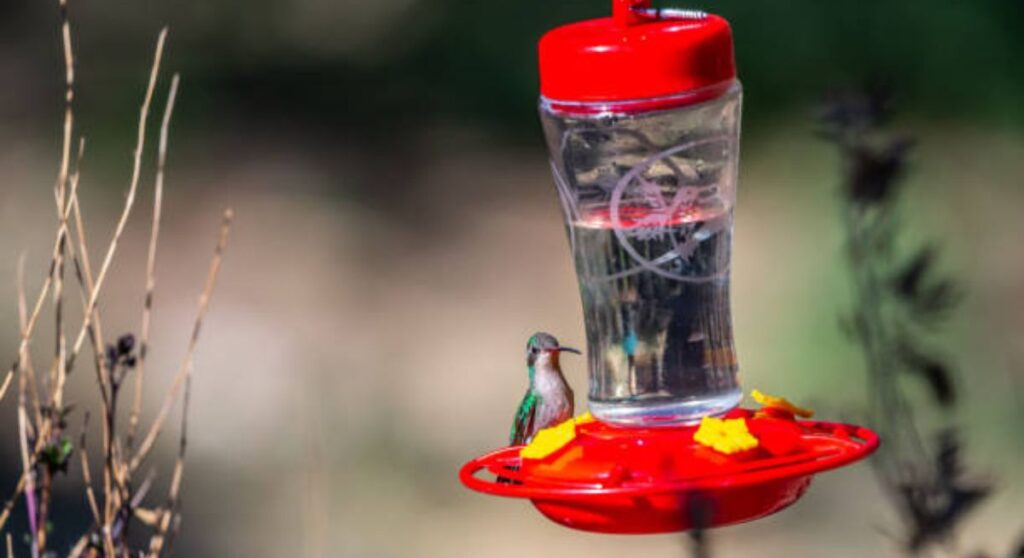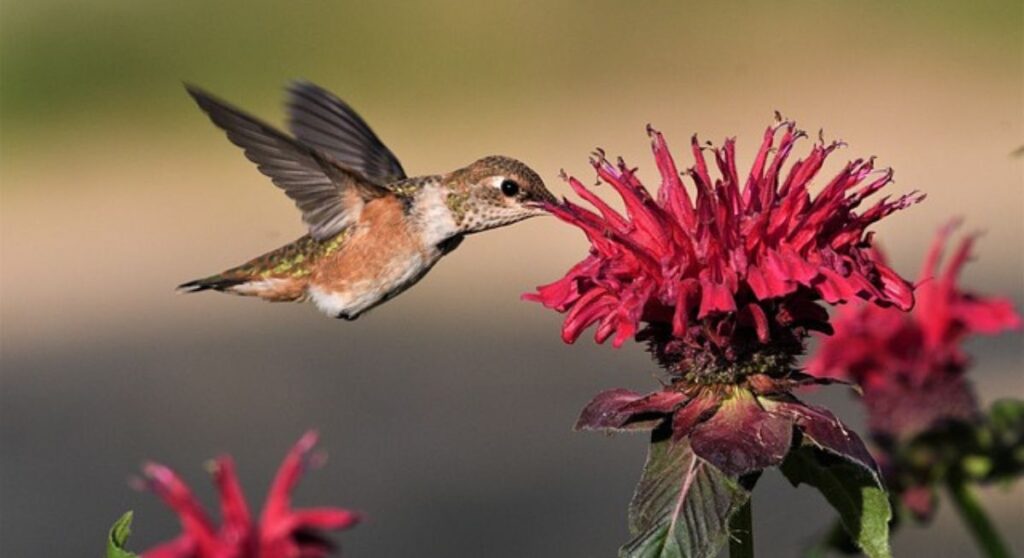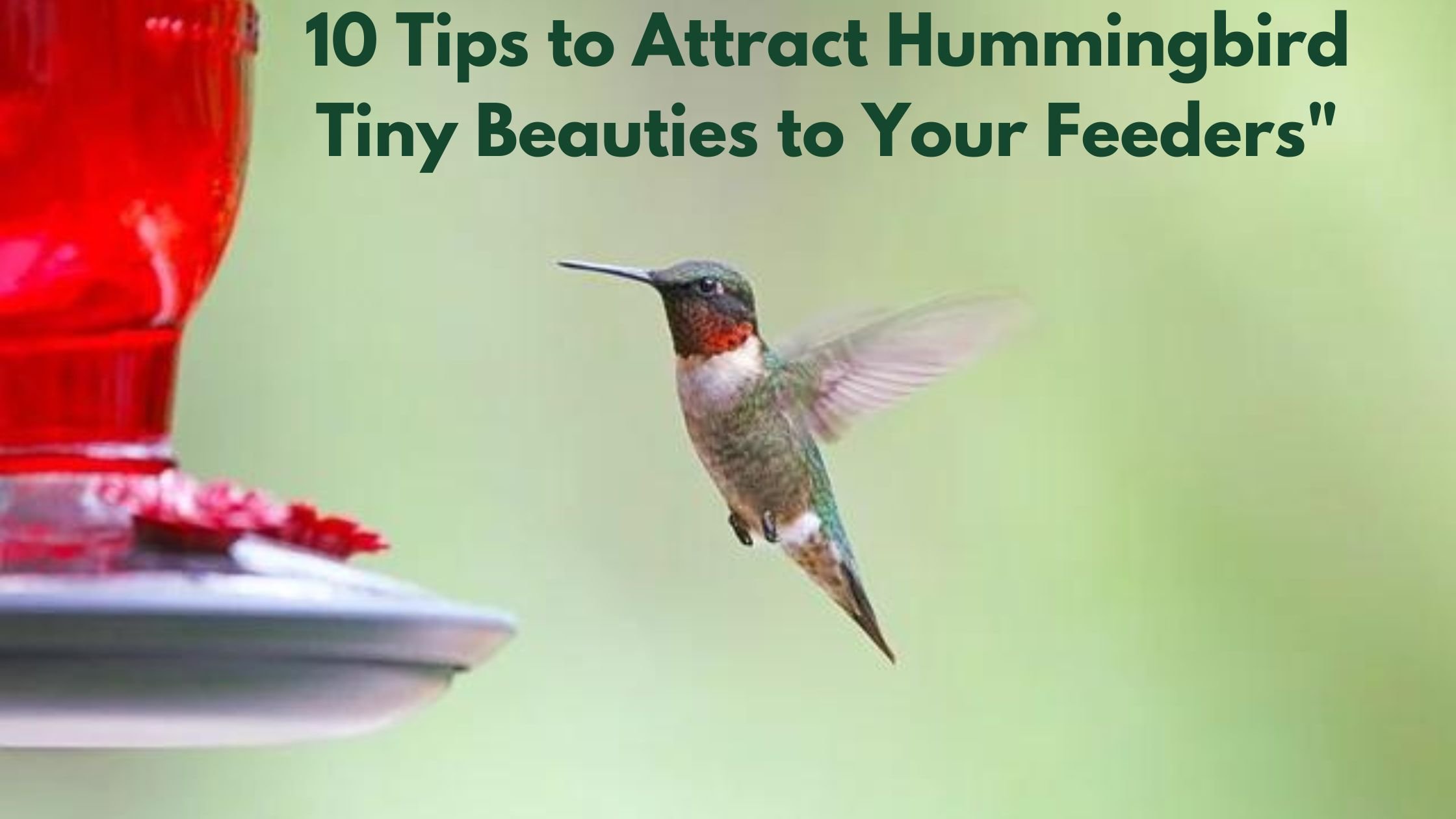Introduction:-
10 Tips to Attract Hummingbird Tiny Beauties to Your Feeders”

Hummingbirds are captivating backyard visitors that serve as essential pollinators. To attract them, it’s important to use the right nectar, place feeders optimally, and create a bird-friendly environment. This guide offers 10 effective tips to turn your outdoor space into a hummingbird paradise, encouraging these delightful birds to visit regularly..
10 Tips to Attract Hummingbird
1. Use the Right Feeder
- Choose a red-colored feeder, as hummingbirds are attracted to red hues.
- Make sure the feeder has small ports and perches that are suitable for hummingbirds’ small size.
- Avoid feeders with yellow accents, as they may attract bees and wasps.
2. Prepare a Simple Nectar Solution
- Make your own nectar by mixing 1 part white sugar with 4 parts water. There’s no need to add food coloring; the red feeder will do the trick.
- Boil the water to dissolve the sugar and kill any bacteria, then let it cool before filling the feeder.
- Avoid using honey, artificial sweeteners, or store-bought mixtures that contain additives or dyes, as they can be harmful to hummingbirds.
3. Clean and Refill Feeders Regularly
- Clean feeders at least twice a week (or more frequently in hot weather) to prevent mold and harmful bacteria from developing.
- Change the nectar every 2-3 days to keep it fresh, especially in warm climates where it can spoil quickly.
4. Place Feeders in the Right Location
- Hang feeders in sunny areas, as hummingbirds are more likely to visit brightly lit spaces.
- Choose spots that are easy to spot, such as near flowering plants or along open pathways where the hummingbirds can see the feeder while flying.
- If possible, place feeders near shade in the afternoon to prevent the nectar from overheating.
5. Add Bright, Red Accents
- Hummingbirds are drawn to bright colors, especially red. You can tie red ribbons around the feeder or plant red, orange, or pink flowers nearby to catch their attention.
- Adding reflective objects like red glass beads or decorations can also increase visibility.
6. Create a Hummingbird-Friendly Garden
- Plant nectar-rich flowers like trumpet vine, bee balm, red salvia, columbine, and fuchsia to naturally attract hummingbirds to your yard.
- Choose native plants that bloom at different times of the year to provide a consistent food source.
- Avoid using pesticides, as they can harm both the birds and their food sources (insects and flowers).
7. Provide Water Sources
- Hummingbirds enjoy bathing in fine water mists. Install a mister or dripper near your feeder, as moving water will attract them.
- A shallow birdbath with dripping or flowing water will also entice them to stay longer.
8. Offer Multiple Feeders
- If you’re in an area with a lot of hummingbirds, place multiple feeders around your yard to reduce competition between aggressive males.
- Space the feeders out so that territorial birds won’t chase others away, ensuring more hummingbirds can feed peacefully.
9. Be Patient
- It might take some time for hummingbirds to discover your feeder, especially if you’re setting it up for the first time. Keep feeders up year-round in warmer climates or at least during their migration seasons (spring and fall).
- Hummingbirds are creatures of habit, so once they find your feeder, they are likely to return.
10. Avoid Pesticides
- Hummingbirds feed on insects as well as nectar. Using pesticides in your garden can kill off these insects and harm the birds themselves, so keep your garden pesticide-free to create a healthy environment for them.
By following these tips, you can create a hummingbird haven in your yard, giving these charming birds a reason to visit frequently.
Do hummingbirds prefer certain colors for feeders?
Yes, hummingbirds are highly attracted to certain colors, with red being their favorite. The bright red hue mimics the color of many nectar-producing flowers that they feed on in the wild, making red feeders particularly effective at catching their attention. Here’s more about color preferences:

1. Red
- Red is the top color that attracts hummingbirds because it is associated with nectar-rich flowers.
- Many hummingbird feeders are designed with red bases or accents to entice them.
- You can also enhance your feeder’s appeal by adding red ribbons or decorations nearby.
2. Other Bright Colors
- Orange, pink, and yellow are also attractive to hummingbirds, as they resemble the colors of other flowers they enjoy.
- While yellow can attract hummingbirds, it may also draw bees and wasps, so feeders should minimize yellow accents to avoid this problem.
3. Avoid Dark Colors
- Dark or muted colors, like blue, green, or black, are less effective at attracting hummingbirds, as these colors don’t stand out to them in the same way as brighter tones.
Though red is the most effective color, it’s important to note that you should never add red dye to nectar. The feeder’s natural red color is enough to attract hummingbirds, and dyes can be harmful to their health.ural red color is enough to attract hummingbirds, and dyes can be harmful to their health.
How can I choose the right location for hummingbird feeders?
Choosing the right location for hummingbird feeders is crucial to attract these fast-flying birds and ensure they feel safe while feeding. Here are some tips to help you pick the perfect spot:

1. Place Feeders Near Nectar-Rich Flowers
- Hummingbirds are naturally drawn to areas with blooming nectar-rich flowers. Placing your feeder near plants like trumpet vine, bee balm, or red salvia will help catch their attention.
- The combination of flowers and feeders provides an abundant food source, encouraging them to visit more frequently.
2. Ensure Easy Visibility
- Hang feeders in open areas where hummingbirds can easily see them while flying. Hummingbirds have excellent eyesight and are attracted to brightly colored feeders, especially red ones.
- If your yard is large, consider putting feeders near open spaces or pathways where the birds can spot them easily during flight.
3. Choose a Quiet and Safe Location
- Hummingbirds prefer quiet areas where they won’t be startled by frequent human activity or loud noises. Avoid placing feeders near doorways, patios, or high-traffic zones.
- To help hummingbirds feel safe from predators like cats or large birds, place feeders near trees or bushes where they can quickly retreat to for cover.
4. Provide Shade
- Place the feeder in a spot that gets morning sun and afternoon shade. While hummingbirds are attracted to brightly lit areas, direct sunlight all day can cause nectar to spoil quickly.
- A balance of light and shade helps keep the nectar fresh longer, which is healthier for the hummingbirds.
5. Offer Multiple Feeding Spots
- If you have multiple feeders, place them in different areas of your yard and out of sight from each other. Hummingbirds can be territorial, so spreading out feeders will reduce competition and allow more birds to feed peacefully.
6. Hang Feeders at the Right Height
- Feeders should be hung at a height where you can easily refill and clean them, typically 5-6 feet off the ground.
- This height also keeps the feeder visible to hummingbirds but out of reach from pets or ground predators.
7. Near Water Sources
- If possible, place feeders near misters, drippers, or small fountains. Hummingbirds love water, especially when it’s moving, and the combination of food and water will make your yard even more attractive.
8. Away from Windy Areas
- Avoid placing feeders in locations that are too windy, as strong winds can make it difficult for hummingbirds to hover and feed.
- Choose a sheltered area, such as near a tree or the side of a building, to block the wind but still offer good visibility.
9. Consider Seasonal Movement
- During migration periods, place feeders in spots that are easily visible from the sky, such as near open clearings or high vantage points, so hummingbirds passing through can find them.
10. Avoid Near Windows
- To prevent window collisions, either place the feeder within 3 feet of the window (so birds can’t build up enough speed to hurt themselves) or at least 10 feet away.
- Adding window decals or keeping curtains closed can also help birds avoid flying into glass.
By placing your hummingbird feeder in the right location, you’ll create a welcoming environment where these beautiful birds can feed safely and regularly.
Conclusion:
Creating a hummingbird-friendly environment is a rewarding experience that allows you to enjoy the lively presence of these amazing birds in your yard. By following these 10 simple tips, you can provide them with the perfect feeding spot while also helping them thrive. With the right food, strategically placed feeders, and a welcoming habitat, your outdoor space will soon be buzzing with the flutter of hummingbird wings, giving you hours of enjoyment and a closer connection to nature. Now, it’s time to set up your feeders and get ready to welcome these tiny beauties!
References
Wild Birds Unlimited. Bird Feeding 101: Being Consistent. Wild Birds Unlimited.
National Wildlife Federation. The Importance of Water for Birds. NWF.
RSPB. Encouraging Birds to Nest in Your Garden. RSPB.
Squirrel Proof Bird Feeders. Best Squirrel Baffles. Squirrel Proof Feeders.
Birdwatchers Digest. Attracting Hummingbirds with Color. Birdwatchers Digest.
The Spruce. How to Make Suet for Birds. The Spruce.

